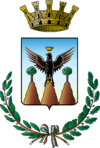Alcamo
| Alcamo | ||
|---|---|---|
| Comune | ||
| Comune di Alcamo | ||
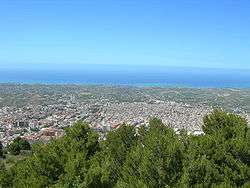 | ||
| ||
 Alcamo Location of Alcamo in Italy | ||
| Coordinates: 37°58′40″N 12°57′50″E / 37.97778°N 12.96389°ECoordinates: 37°58′40″N 12°57′50″E / 37.97778°N 12.96389°E | ||
| Country | Italy | |
| Region | Sicily | |
| Province / Metropolitan city | Trapani (TP) | |
| Government | ||
| • Mayor | Domenico Surdi | |
| Area | ||
| • Total | 130.79 km2 (50.50 sq mi) | |
| Elevation | 256 m (840 ft) | |
| Population (31 December 2015) | ||
| • Total | 45,504 | |
| • Density | 350/km2 (900/sq mi) | |
| Demonym(s) | Alcamesi | |
| Time zone | CET (UTC+1) | |
| • Summer (DST) | CEST (UTC+2) | |
| Postal code | 91011 | |
| Dialing code | 0924 | |
| Patron saint | Madonna of the Miracles | |
| Saint day | 21 June | |
| Website | Official website | |
Alcamo (Sicilian: Àrcamu) is the fourth-largest town in the province of Trapani in Sicily, with a population of 45,307 inhabitants. It is situated on the borderline with the Metropolitan City of Palermo at a distance of about 50 kilometres both from Palermo and Trapani.
Nowadays the town territory includes an area of 130.79 square kilometres and is the second municipality as for population density in the province of Trapani, after Erice.[1]
Alcamo is bounded by the Tyrrhenian Sea on the north, Balestrate and Partinico on the east, Camporeale on the south and Calatafimi-Segesta and Castellammare del Golfo on the west. Its most important hamlet is Alcamo Marina which is about 6 kilometres from the town centre. Together with other municipalities it takes part with the Associazione Città del Vino, the movement Patto dei Sindaci, Progetto Città dei Bambini, Rete dei Comuni Solidali[2] and Patto Territoriale Golfo di Castellammare.[1]
Geography
Territory
Alcamo is situated in the middle of the Gulf of Castellammare, at 258 metres above the sea level and at the foot of Mount Bonifato, a calcareous complex 825 metres high. At the altitude of 500 metres (near the "Funtanazza") there is the Nature Reserve of Monte Bonifato.
The territory of Alcamo includes also Alcamo Marina, used mainly as a summer resort.
Climate
The climate is mild, with higher rainfall during winter than summer.[3]
The average annual temperature is 16.9 °C,[3] with higher temperatures in August (24.8 °C)[3] and lower temperatures in February (10.3 °C).[3]
The average annual rainfall is 558 mm.[3] Rainfall is particularly scarcer in July (4 mm)[3] and more abundant in December (83 mm).[3]
| Climate data for Alcamo | |||||||||||||
|---|---|---|---|---|---|---|---|---|---|---|---|---|---|
| Month | Jan | Feb | Mar | Apr | May | Jun | Jul | Aug | Sep | Oct | Nov | Dec | Year |
| Average high °C (°F) | 13.1 (55.6) |
13.2 (55.8) |
14.8 (58.6) |
17.5 (63.5) |
21.5 (70.7) |
25.4 (77.7) |
28.5 (83.3) |
28.7 (83.7) |
25.9 (78.6) |
21.7 (71.1) |
17.7 (63.9) |
14.4 (57.9) |
20.2 (68.37) |
| Daily mean °C (°F) | 10.4 (50.7) |
10.3 (50.5) |
11.7 (53.1) |
13.9 (57) |
17.6 (63.7) |
21.4 (70.5) |
24.5 (76.1) |
24.8 (76.6) |
22.4 (72.3) |
18.6 (65.5) |
14.8 (58.6) |
11.8 (53.2) |
16.85 (62.32) |
| Average low °C (°F) | 7.7 (45.9) |
7.5 (45.5) |
8.6 (47.5) |
10.4 (50.7) |
13.8 (56.8) |
17.5 (63.5) |
20.5 (68.9) |
21.0 (69.8) |
18.9 (66) |
15.5 (59.9) |
12.0 (53.6) |
9.2 (48.6) |
13.55 (56.39) |
| Average precipitation mm (inches) | 72 (2.83) |
60 (2.36) |
52 (2.05) |
48 (1.89) |
21 (0.83) |
9 (0.35) |
4 (0.16) |
14 (0.55) |
37 (1.46) |
78 (3.07) |
80 (3.15) |
83 (3.27) |
558 (21.97) |
| Source: Climate-Data.org[4] | |||||||||||||
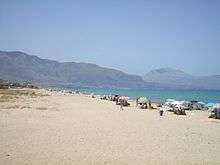
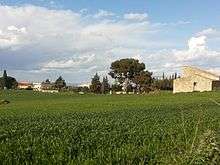
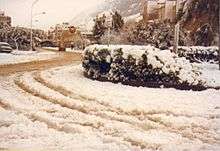
- Seismic classification: zone 2 (medium-high seismicity), Ordinance PCM 3274 (20 March 2003)
- Climatic classification: zone B, 1140 degree day[5]
- Köppen climatic classification: CSa[3]
- Atmospheric diffusivity: low, Ibimet CNR 2002
History
Etimology
There are discordances about the etymology of the toponym "Alcamo". One of the hypothesis connects the present name to the Arab word al-qama, which would mean "muddy earth" or "rich soil".[6] Another supposition is that it had been derived from the name of the Muslim leader who probably founded the town in 828 AD and whose name was al-Qāmūq (in Arabic: القاموق). According to some people this hypothesis was invented by Leo Africanus who had told this story without consulting any document on the subject.[7] Besides, according to some scholars, the name Alcamo would derive from caccamu, a dialectal word referring to the plant Citrullus colocynthis.[6]
Prehistory
Though there is little information about it, there are evidences that Alcamo territory was inhabited even in prehistoric times; in one of the oldest sites, near "contrada" Molinello (a country district), they discovered archaeological findings dating back to the Mesolithic, approximately to about 9,000–6,000 BC[8] and other very old ones dating back to the Neolithic during the archaeological excavations done by the archaeologist Paolo Orsi (1899) and the marquis Antonio De Gregorio (1917) near the river Fiume Freddo.[9] One of the most important finds is an axe from the Neolithic kept at the Museum Paolo Orsi of Syracuse.[8]
Longuro and Longarico
From the quotations by Lycophron we know that in old times there was an inhabited centre on Mount Bonifato called "Longuro".[10] According to an old story, this settlement was founded by a Greek colony which had escaped from the destruction of the town of Troy.[11]
During the Roman period the inhabitants of Longuro moved to the foot of the mountain so they could practice agriculture in the surrounding lands.[10] The town was called "Longaricum";[10] this name appears in the Itinerario di Antonino Pio (3rd century AD)[10] and would coincide with the Latin name of Longuro.[12]
According to a supposition the two hillocks appearing on Alcamo gonfalon would represent both the towns of Longaricum and Longuro.
Origins
Alcamo was founded in 828 by the Muslim commander al-Kamuk (after whom it is probably named), though other sources date its origin to about 972.
The first document mentioning Alcamo is dating back to 1154, in a paper written by the Berber geographer Idrisi who was given this task by Ruggero II[13] in order to get a collection of geographic maps. From a distance longer than an Arab mile, the writer describes the position of Alcamo viewed from the Castle of Calatubo (visible even today from the town territory) and defines it as a "manzil", that is a hamlet or a group of houses with rich soil and a flourishing market.[13] This hamlet was called "Alqamah" by Arabs.[14] In a diary of 1185 the Andalusian pilgrim Ibn Jubayr confirms the Arab origin of the town;[13] in fact during his travel from Palermo to Trapani he stopped at Alcamo and describes it as a beleda (town) with mosques and a market whose inhabitants were of Muslim religion.[13]
Medieval age
_-_Vista_laterale.jpg)
In the Middle Ages Alcamo was largely inhabited by Muslim people, whose numbers declined after the Norman conquest of Sicily, begun in 1060. Alcamo was divided into four hamlets named San Vito, San Leonardo, Sant'Ippolito and San Nicolò del Vauso.[15] but a series of Arab revolts between 1221 and 1243 led King Frederick II to move most of the Arab population[16] to a colony at Lucera, while Christians from Bonifato came to inhabit the town. In this period the famous poet Ciullo or Cielo d'Alcamo was born.
In 1340 Raimondo Peralta acquired the feud and barony of Alcamo from Peter II of Aragon.[14][17] Then the barony passed to his son Guglielmo Peralta Sclafani, called "Guglielmone".[17] and afterwards to the Ventimiglia family (up to 1397), Giaimo de Prades (1407), the Cabrera family, the Speciale family, Pietro Balsamo prince of Roccafiorita (1618) and finally to Giuseppe Alvarez (1777).[14]
In the 14th century Alcamo had several thousands of inhabitants[18] and hundreds of them had immigrated from different parts of Sicily and Italy (in particular: Pisa, Amalfi, Bologna, Calabria, Liguria), and some also from Spain.[18] During this period, Antonello da Messina moved to Alcamo for three years (around 1438–1441) in order to learn the tanning techniques from the tanner master Guglielmo Adragna di Alcamo.[18] In fact the town was an important pole of development for commerce and handicraft.[19] In particular, it had a massive exchange of wheat and wine with the nearby towns[19] and there were also expert artisans such as bakers, blacksmiths, tanners and weavers.[19] During this century Alcamo was an important centre for wheat storage and sorting.[19] In the same period the writer Giacomo Adragna transcribed the Commentarii in Persium and Pietro d'Alcamo many works from the library of San Martino.[20]
Modern age
.jpg)
About the year 1500, Alcamo was under the jurisdiction of the captain of justice Ferdinando Vega, who fought against the raiding Turkish pirates. The town was surrounded by defensive embattled walls provided with four gates:[21]
- Porta Palermo (afterwards called Porta Saccari), at the end of the present via Rossotti;
- Porta Corleone, at the end of the present via Commendatore Navarra;
- Porta di Gesù, opposite the church of Saint Mary of Jesus, next to the Franciscan friary;
- Porta Trapani (later called Porta del Collegio), at the beginning of via Commendatore Navarra.
During this period, the town was divided into four-quarters, each one associated with the name of the main church in that area:[22][23]
- San Giacomo de la Spada
- San Calogero
- San Francesco d'Assisi (or "Terra nuova"[24])
- Maggiore Chiesa.
The division between these quarters was coincident with the main streets of the town, that are the present Corso VI Aprile and Via Rossotti and its continuation via dei Baroni Emanuele di San Giuseppe[22] (called incorrectly "Via Barone di San Giuseppe"[24]).
In 1535, in coincidence with the visit of the emperor Charles V, coming back from Tunisia, the old Porta Trapani was closed and four gates were opened:[21]
- new Porta Trapani, near the beginning of the present Corso VI Aprile (that was called "Corso Imperiale");
- new Porta Palermo (initially called Porta San Francesco), at the end of today's Corso VI Aprile;
- Porta Stella, at the corner between Via Stella and Piazza Ciullo; this name derives from the name of the church Mary of the Star (in Italian "Madonna della Stella"), near there;
- Porta Nuova, between the present Discesa al Santuario and Piazza della Libertà.
_-_Facciata.jpg)
During the 16th century there was a development in education in Alcamo because of the construction of new schools and the activity of expert teachers, in particular the poet and scholar Sebastiano Bagolino (1562–1604).[20][23] In 1547 the Madonna appeared to some women of the people and an image of Madonna Fons Misericordiae was discovered and worshipped as "Our Lady of Miracles".[25]
In the late 16th century, the population was decimated by a pestilence.[26] The victims were buried in the cemetery of Saint Ippolito.[26]
In 1667 Mariano Ballo ordered the construction of a theatre, called "teatro Ferrigno", later demolished and rebuilt during the 1960s. After the reconstruction it was first called "cine-teatro Euro", and later "teatro Cielo d'Alcamo".
.jpg)
During the 18th century, pestilence and popular rebellions occurred in Alcamo again.[26] On the other hand, this age was important for art because of the construction of the Basilica of Our Lady of the Assumption (1699), designed by the architects Angelo Italia and Giuseppe Diamante.[14] Its interior was decorated also with 38 frescos by the Flemish painter Guglielmo Borremans between 1736 and 1737.[14] In the same period the Church of Saint Olivia was renovated, Saint Paul and Bartholomew's Church was rebuilt (1689),[26] and the church Saint Francis from Paola was completed (1699)[27] together with the monumental church of College some decades later(1767).[27]
The population of the town, gradually recovered from the pestilence and increased to 13,000 in 1798.[26]
Contemporary age
At the beginning of the 19th century Alcamo's feudal status was abolished (1812)[14] and the town became a direct royal possession.[23]
The archpriests Stefano Triolo Galifi and Giuseppe Virgilio, together with the baron Felice Pastore were members of the Sicilian Parliament as representatives of Alcamo.[27] In 1820, during a revolt, there were different murders, sacks, release of criminals from prison and a fire in the municipal archives[28] and in 1829 many people died of cholera.[28] In 1843 the construction of the present Town Hall started, on a land of the baron Felice Pastore.
On 6 April 1860, Stefano and Giuseppe Triolo let the Italian Tricolour wave on the Town Hall,[28] creating groups of volunteers in order to help Giuseppe Garibaldi in the battle of Calatafimi and from Alcamo some dictatorial edicts on Victor Emmanuel II's behalf were issued. Some time later Francesco Crispi prepared the Constitution for the lands set free. Further to this event, Corso Imperiale was named Corso 6 Aprile, in memory of 6 April, in which the volunteers started to be enlisted in Alcamo.[23]
During the Unification of Italy the brothers Triolo of Sant'Anna and Giuseppe Coppola of Monte San Giuliano enlisted many citizens from Alcamo to fight with the Garibaldians in 1860.[14]
.jpg)
At the end of the 19th century, in 1897, public lighting was inaugurated in Alcamo during the traditional feast of Our Lady of Miracles. Among the most important people of this period we have to remind Don Giuseppe Rizzo, a priest who founded the bank called "Cassa Rurale e Artigiana Don Rizzo" (1902).[30]
At the beginning of the 20th century (1901–1911) the number of citizens in Alcamo diminished abruptly, partially because of the emigration of 36,718 Sicilians from Sicily abroad and in particular to the United States,[31] but it is possible that the statistics about this year and the previous years were not reliable because the census was carried out without following certain criteria.[32] In the same period the cultivations in the territory of Alcamo were affected by phylloxera and two banks ("Cooperativa" and "Segestana") went bankrupt with subsequent economic difficulties for Alcamo's citizens.[33]
There were also some events linked to mafia, such as the murder of Gaspare Cottone, a carter (1899)[30] and the death of the 19 years old Benedetto Guastella during a fire conflict with carabinieri in 1900.[30] As the mafia had taken power in the districts of Trapani and Alcamo,[30] the commissary Cesare Mori intervened with a series of arrests and charges against the material executors of the crimes occurred in the area[30] and finally with the arrest of Vincenzo and Michele Tedesco, brothers, and Baldassare Adragna, considered the heads of the gangs in Trapani's territory.[30]
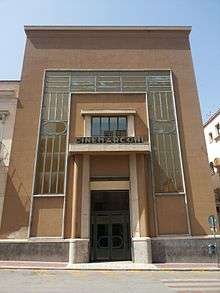
During the First World War, four hundred citizens from Alcamo died[28] and the following period was characterized by poverty because of monetary inflation and banditry. In 1918 about five hundred people died because of Spanish flu[28] and in the Second World War 213 citizens from Alcamo died or were lost.[28]

The foundation of Società Elettrotecnica Palermitana,[34] whose name was changed into Società Generale Electrica della Sicilia (SGES) and which installed an important electric workroom in the district of Saint Augustine in Alcamo, dates back to the twenties.[34] The jobs inside this firm were very longed-for because it was the only firm in Trapani Province which had a Health insurance fund and granted holidays.[34] The electric workroom existed until 1963 when it was acquired by Enel and demolished.[34] During the years in which SGES operated, there was an improvement of the electric services in Alcamo's territory, owing also to the realization of several artificial lakes.[34]
During Fascism, the citizens of Alcamo asked the government to appoint Alcamo as the capital of the province (1930), but this request was not satisfied.,[28] however some important infrastructures were built in Alcamo, in particular:[35]
- The Railway station of Alcamo Diramazione
- The cinema-theatre Marconi
- The aqueduct between Alcamo and Castellammare del Golfo (1922–1925)[36] and the communal water reservoir at Mount Bonifato (called "bottino")
- The anti-tuberculosis profylaxis dispensary
- The Carabinieri's post
- The building of the present Classical Lyceum "Cielo d'Alcamo".
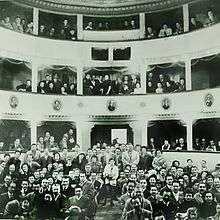
On 19 August 1937 the fascist leader Benito Mussolini visited Alcamo crossing Corso VI Aprile by an open car and parading through the crowd of his supporters.[37] The visit was due to the inauguration of the railway line between Trapani and Alcamo, completed in the same year.[38] Some weeks later, prince Umberto visited Alcamo too.[37]
On 21 July 1943 the American troops entered Alcamo without any opposition,[28] freeing the town from Italian Fascism. On 18 December 1944, because of the economic and social discomfort, the citizens raised up, occupied the Town Hall and put its archives on fire.[28] Since 1960 the town planning system has been greatly expanding, particularly at the foot of Mount Bonifato with the construction of Viale Europa, which is one of the most important street in Alcamo.
At about the end of the 1980s and the beginning of the 1990s there was a bloody Mafia war between the clan Greco (related to the Rimi family) and the members of the emergent Mafia of Corleone, led by the boss Vincenzo Milazzo in the territory of Alcamo. Vincenzo Milazzo received orders from Totò Riina to eliminate members of the old Mafia (in particular the member of the clan Greco) and put in command only his trusted men. Just for this reason the Greco family represented an obstacle: the cause which roused the conflict was the approaching of some members of Cosa Nostra to the rival clan of Grecos. The war bathed the town in blood for about five years and provoked tens of victims. The new Corleone's mafia prevailed, but the cost to be paid was very high, because a lot of members of this clan died. During the same period, in which there were armed clashes between the Mafia families, at contrada Virgini in Alcamo, they discovered the biggest heroin refinery in Sicily. (1985)[39] Tens of people died in five years, and at the end the Mafia of Corleone prevailed.
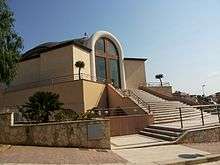
While the crimes of mafia went on and tens of people disappeared as victims of "lupara bianca",[40] in Alcamo there was a religious revival which led to the birth of several Catholic associations such as Rinnovamento nello Spirito Santo, Cammino neocatecumenale and the movement of Comunione e Liberazione.[41] From the last one the parish community of the Church of Gesù Cristo Redentore (Jesus Christ the Redeemer) originated in the district of Sant'Anna (2006).[41] This religious revival was followed by a new interest into the old Alcamo's traditions that are mentioned in the works of Roberto Calia and Carlo Cataldo, historians from Alcamo.[41] Carlo Cataldo has also been prized several times both for his historical works and for his dialectal poems which tell Alcamo's folkore.[41]

In the 21st century there was a renovation of Alcamo's architectural context, thanks to the restoration of some important historical buildings such as the Castle of the Counts of Modica, the Theatre Cielo d'Alcamo, the Cine-Theatre Marconi, the Ex Jesuits' College, the Cuba delle rose (in 2013), church of College (in 2014), the façade of Badia Nuova (in 2014) and the old Arab fountain (in 2016). Thanks also to the intervention of Fondo Ambiente Italiano, it is expected the restoration of the Castle of Calatubo; its chapel and the path leading to the castle have already been cleaned by the volunteers' association "Salviamo il Castello di Calatubo" (in 2015).[42]
Among the works of revalutation of the urban areas there are the restoration of Piazza Ciullo by the architect Gae Aulenti (1996)[43] and the realization of an underground car park in Piazza Bagolino, together with the creation of the near suburban park.
The interest in the environment is also associated with that in the territory. In fact, after the adhesion to the initiative "Rifiuti Zero" (Zero Rubbish), the town of Alcamo has been considered an example to be followed for the results got between 2010 and 2013 in the field of waste sorting (raccolta differenziata).[44]
Coat of arms
The Coat of arms of Alcamo used since the kingdom of Frederick II of Swabiais a black flying Eagle, crowned by Gold in a Silver range, with three hills below and two Golden Oaks.[45]
A sculpture of the coat of arms is put on a side wall of the Church of Saint Francis of Assisi, near Porta Palermo.
.jpg)
Main sights
Civil buildings

There are several historical civil buildings in Alcamo:
- Casa di Ciullo d'Alcamo (piazzetta Leopardi n°3, near the Church of Saint Francis of Assisi (Alcamo)
- Casa De Ballis (in Via Mariano de Ballis): built in the 16th century, with a square tower with battlements, adorned with a round arch that contains two windows, a double lancet and one triple lancet;[47] it was probably designed in 1490 by Tommaso and Pietro Oddo[24]
- Ex Loggia Comunale (1500): built after the design of the architect Domenico Vitale, it has a base made with travertine and the upper part in calcarenite. It was used as a loggia from 1525 to 1767; It is located at the corner between Corso 6 Aprile and via Barone di San Giuseppe.
- Palazzo Aversa (in via Porta Stella n°48): it has balconies in carved stone and the coat of arms, with a red lion looking at a red comet.
- Palazzo D'Angelo (between corso 6 Aprile and via Fratelli sant'Anna), built in 1768
- Palazzo D'Angelo (Piazza Ciullo n°12): of XIX century
- Palazzo De Stefani (via Commendatore Navarra, opposite Badia Nuova): in Liberty style, was built in the 19th century
- Palazzo Diana (or Termine): it is located at the corner between via Ignazio de Blasi and Corso 6 Aprile; there are two small columns at the corner, one double lancet window in via De Blasi, with the Diana's coat of arms and a cornice similar to Gothic style above the door
- Palazzo Di Gregorio (in via Dante): built in about the 17th century;[47]
- Palazzo Ferrando-Mistretta (between via Diaz and via Sant'Oliva)
- Palazzo Ferrara (at the corner of via Francesco Crispi and via Ruggero Settimo): in classical style, built in 1909;[47]
- Palazzo Fraccia (in via 11 Febbraio): in Baroque style, built in 1700 by the baron Agostino Fraccia;[47]
- Palazzo Guarrasi (via 15 Maggio n°15): built in the early 18th century
- Palazzo Mistretta Galati, earlier palazzo Fraccia (between Piazza Bagolino and corso 6 Aprile): in Liberty style
- Palazzo Morfino (via Giuseppe Fazio n°17) built in the 18th century
- Palazzo Palmerini: at the corner of via Madonna dell'Alto and via Buonarroti
- Palazzo Pastore (in Corso 6 Aprile, near Piazza Ciullo): in neoclassic style, built at the end of the 18th century;[47] Some elements of the façade are similar to those of Basilica and Palazzo Di Gregorio in via Dante.
- Palazzo Patti (Piazza Ciullo n°24): built in the 18th century;[47]
- Palazzo Peria (corso 6 Aprile n°102, opposite Centro Congressi Marconi): built in 1700, it has two floors, restored with the system Livigny; in 1806 it was the seat of the municipality[47]
- Palazzo Pia Opera Pastore, designed by the architect Giovan Battista Palazzotto in 1872;
- Palazzo Polizzi (between corso 6 Aprile and Via Don Rizzo)
- Palazzo Quattrocchi (built in the 18th century), in via 15 Maggio n°47
- Palazzo Rocca (in Corso 6 Aprile): built in 1629. It is one of the most remarkable buildings; inside it there is a beautiful garden.[47]
- Palazzo Rossotti-Chiarelli (in via Rossotti): in baroque style, built in the 18th century; it has an artistic main door and some magnificent balconies with iron railings[47]
- Palazzo Speciale (in corso 6 Aprile n°51, at the corner with via Mariano de Ballis): built at the end of the 18th centuries; its balconies have wrought iron railings.
- Palazzo Triolo (between Corso 6 Aprile and via Fratelli Sant'Anna): built at the end of the 18th century, it belonged to the barons of Sant'Anna
- Palazzo Velez (in Via Buonarroti, behind the Basilica of Our Lady of the Assumption): built between 1600 and 1700, it has a beautiful internal garden.
- Palazzo Virgilio (between Corso 6 Aprile and via Stefano Polizzi): built at the end of the 18th century
- The Town Hall (in Piazza Ciullo): in Neoclassic style, built in 1843;[47]
- Villa Luisa (between via Madonna Alto Mare, via Rossotti and via Federico II): built in 1903 in Liberty style with a Moorish trend, after a project of the architect Francesco Naselli.[47]
Religious buildings
14th century
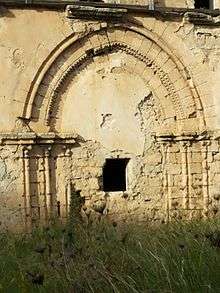
_02.jpg)
- The Church of our Lady of the Star (Chiesa di Santa Maria della Stella) which is abandoned now, was the first Mother Church of Alcamo since 1313.[48] It was located in the old district of San Vito[49] and inside it there was the painting of Our Lady of Honey (Madonna del Miele) dated 1300 and later moved into the Saints Paul and Bartholomew's Church:[50] they believe this painting is the oldest one in Alcamo.[51][52]
- Ex Church of Saint James of the Sword (Ex Chiesa di San Giacomo de Spada): built before 1529, it was enlarged between 1625–1636.[53]
- Church of saint Vito (Chiesa di San Vito): it gave the name to the ancient district of San Vito and to the street where it is located. It was already existing in 1492 and, according to Ignazio de Blasi (a historian from Alcamo), it was founded by a member of the Confraternity of the Annunciation, together with a hospital for poor people next to it.[54] It was restored in 1922 and some decades ago; there is nothing old in it and today is used by Eastern Orthodox Church Christians for their rites.
15th century
- Church of Saint Thomas (Chiesa di San Tommaso): the date of its construction is uncertain, probably the first half of the 15th century.[55][56] It is faced by a great portal with geometrical decorations.
- Church of Saint Mary of Jesus (Chiesa di Santa Maria di Gesù): built in the 15th century and enlarged in 1762.[57] It holds the body of the Blessed Arcangelo Placenza from Calatafimi.
- ex Church of saint Maria del Soccorso (Ex Church of Our Lady of Rescue): built in the 15th century.[58]
_-_Portale_di_San_Tommaso.jpg)
16th century
.jpg)
- Church of the Holy Saviour (Alcamo) (Chiesa del Santissimo Salvatore or "Badia Grande") is very important from the artistic point of view; it was built in the 14th century baroque style and rebuilt around the middle of the 15th century and between 1690–1697.[59] Inside it there are pictures by Novelli dating back to the mid of the 17th century.
- Church of Saint Olivia (Chiesa di Sant'Oliva) was built in1533 and renovated in 1724.[60][61]) Inside there are a picture by Pietro Novelli on the main altar ("Sacrificio della Messa" dated 1639)[14] and works by the Gagini.
- Sanctuary of Madonna of Miracles (Santuario di Maria Santissima dei Miracoli): built in 1547.[62][63]
- Church of the Holy Crucifix (or saint Francis of Paola) , (Chiesa del Santissimo Crocifisso): built in 1550.[64] Now it is the Parish of Saint Francis of Paola
- Church of the Annunciation (Chiesa dell'Annunziata o del Carmine): built in the 14th century, it was rebuilt in 16th and 17th centuries but collapsed in 1866.[65][66]
- ex Church of Saint Nicholas from Bari (Ex Chiesa di San Nicolò di Bari): built in 1430, demolished and rebuilt in 1558.[67]
- Church of saint Augustine (Alcamo) (1589)
17th century
_-_n._13790_-_Alcamo_-_Cattedrale_e_campanile.jpg)
- Basilica of Our Lady of the Assumption was realized during the 14th century and rebuilt in 1669; the present façade was realized in 1786;[68] the portal and the bell tower are the only remains from the original church of the 14th century. It is located in the centre of the town, near piazza Ciullo. The interior is tripartite and contains frescoes by Guglielmo Borremans. In the apse and side chapels there are works by Antonello Gagini, called "Madonna with the Saints Philip and James", the "Crucifix" and the "Transit of the Virgin".[14] There are also other works made by his apprentices. In a chapel there is also "The Holy Thorn".[69] In 2010 the Sacred Art Museum was opened: it contains many works from other churches. On the right, in the first chapel, there is also a modern architectural work dedicated to Don Rizzo (founder of the homonymous bank), designed by the architect Paolo Portoghesi.
- Church of Saint Francis from Assisi (Chiesa di San Francesco d'Assisi): built between the years 1224–1226, demolished and rebuilt between 1608–1648.[70] Inside it there are a marble ancon, probably by Domenico Gagini, and two sculptures reproducing the Maddalena and Saint Mark, both ascribed to Antonello Gagini.
- Church of Saints Paul and Bartholomew (Chiesa dei Santissimi Paolo e Bartolomeo) built between 1615 and 1689,[71][72] has got characteristic baroque features and holds a very ancient and valuable picture, the Madonna del Miele (made about the year 1300).
- Church of Santa Maria delle Grazie (Church of Our Lady of Graces) : built in 1619 and enlarged between 1626 and 1636[73]
- Church of Saint Anne (Chiesa di Sant'Anna (1630–1634)[74])
- Ex Church of Saint Peter (Ex Chiesa di San Pietro): Via Barone di san Giuseppe,19.It was built in 1367 and reconstructed in the years 1645–1649, then enlarged in 1742 after the design of Giovanni Biagio Amico, an architect. The artistic portal(1649) is on the main door.); the roof fell down because of the 1968 Belice earthquake.
- Church of the saint Guardian Angel or Sheltered People (Chiesa del S.Angelo Custode or Chiesa delle Riparate, 1647[75])
- Church of the Holy Family, built in the XVI century; in Piazza Ciullo
- ex Collegio dei Gesuiti (Ex Collegio dei Gesuiti): built in the 17th century, in the 18th century they added an arcade.
- Church of the College of Jesuits or Church of Jesus (Chiesa del Collegio dei Gesuiti or Chiesa del Gesù): built between 1684–1767.[76][77]
- Church of Our Lady with a Chain (Chiesa Maria della Catena): Built in 1661 it hosts a portrait of Our Lady with a Chain, ascribed to Giuseppe Renda (18th century).
- Ex Church of Saint Catherine of Monte di Pietà (Ex Chiesa di Santa Caterina del Monte di Pietà): in corso 6 Aprile, at the corner of Via Barone di San Giuseppe. Its façade, with a simple portal, was made in 1608 and the painting of Saint Catherine of Alexandria (1621), realized by Giuseppe Carrera or Giacomo Lo Verde, is now kept at the Sacred Art Museum.
18th century
_02.jpg)
- Saints Cosma and Damiano's Church (Chiesa dei Santi Cosma e Damiano or Santa Chiara): built in 1500 and rebuilt between 1721–1725[78][79]). It has a baroque style and inside it there are two sculptures by Serpotta.[80]
- Badia Nuova or (Monastero di San Francesco di Paola'), not to be confused with the homonymous Church) was built in 1531, demolished in 1699 and rebuilt in the first half of the 18th century.[81][82] There are a picture by Pietro Novelli and some allegorical representations by Giacomo Serpotta.[14]
- Church of the Most Holy Trinity (Chiesa della Santissima Trinità): 1746–1757[83]
- Ex Church of Ecce Homo (Ex Chiesa dell'Ecce Homo, 1750)[84]
- Church of Our Lady of the Rosary (Chiesa di Santa Maria del Rosario): built in 1660 and reconstructed in 1761.[85]
20th–21st centuries
- Sanctuary of Most Holy Mary of the Height (Santuario di Maria Santissima dell'Alto): built in 929 and reconstructed in the 20th century.[86]
- Santuario Maria Santissima del Fiume, Strada Statale 113 (past the A29 motorway junction Alcamo Ovest). Built in the second decade of the XX century, it is frequented by believers in May, mostly on Saturday morning. There is a wooden statue of the Madonna and, on the ceiling, a fresco by Liborio Pirrone, a painter from Alcamo.
- The small church of the Most Holy Saviour: already known in 1379, lately restored in 1942: Its façade was rebuilt in gothic style
- The small Church of Madonna del Riposo (Alcamo): built in 1656 and restored in 1939, it is located at the end of the homonymous street.
- Church of Saint Joseph the Worker (Chiesa di San Giuseppe Lavoratore), built in 1947.
- Church of the Holy Souls in Purgatory (Chiesa delle Anime Sante del Purgatorio): built in 1813, demolished and rebuilt in 1958[87])
- Church of the Holy Heart (Alcamo) (Chiesa del Sacro Cuore): built in 1967[88])
- Church of Jesus Christ the Redeemer (Chiesa Gesù Cristo Redentore):[89] built in 2006.
Military buildings
Military buildings in Alcamo include:
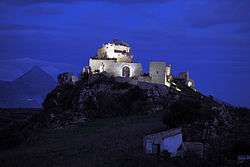
- The Castle of the Counts of Modica (or "Castle of Alcamo"): probably built in the 14th or 15th century by the Peralta family and then completed by the feudatories Enrico and Federico Chiaromonte. In 1535 the emperor Charles V lodged there. It was a possession of the Cabreras and then of the Counts of Modica, until 1812. Later, during the Reign of Italy and until 1960, it was used as a prison. It has a rhomboidal shape, with four towers: two quadrangular at the corners and the other two are connected by curtains and are cylindrical. In each tower there were a torture room for prisoners, rooms for sentinels and for passing guest sovereigns. One of the particular characteristics of the castle is given by the thick walls which bound it and that in old times defended it from the enemies' attacks extremely well.
- Castle of Ventimiglia: situated on the top of Mount Bonifato. It is a medieval castle and today there are only some parts of the walls, the primary tower and the dungeons. It took the name from Enrico Ventimiglia, who declared he had built it just for defence, though according to some interpretations, it would date back to a previous period.[90]
- The Calatubo Castle, outside the town but inside its territory and on the road leading to Palermo, is a fortress built in the early Middle Ages. The homonymous village of Calatubo stood nearby and its commerce was based on the exportation of cereals and millstones.[91] In the same place there is an old necropolis dating back to the 6th century BC.[92]
- The watchtower located in the town centre, in Corso 6 Aprile, next to the chiesa della Madonna del Soccorso (Church of Holy Mary's Aid), opposite the Mother Church. Its construction dates back to 980 A.D. and is the oldest architectural work existing in Alcamo, in perfect preservation conditions.[93] Later the tower was bought by the diocese (1400) and used as a bell tower for the near Mother Church which, at the time, didn't have one.[93] They put then two bells on its top, the remaining one is on the west, while the smaller one on the north side was dismounted at about 1950 for safety reasons.[93] Inside the building you can see a stone winding staircase with 84 steps, 50 of them are original ones.[93]
Archaeological sites
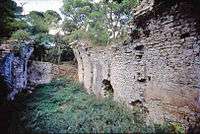
In the territory of Alcamo there are several and interesting archaeological sites:
- the ruins on Mount Bonifato[10] include Funtanazza (probably used as a water reservoir), Porta Regina, the Castle of Ventimiglia, the snowfields and the remains of the ancient village of Bonifato;
- the ruins in the area of Calatubo, which include the Castle of Calatubo, the necropolis near it and the ruins of the surrounding village.[92]
- the ruins of the ancient Roman furnaces at Alcamo Marina, used to produce tiles and bricks;[94]
- the archaeological site in Contrada Mulinello, where they have discovered finds dating back to the Mesolithic period;[8]
- the area near Fiume Freddo where archaeological finds from the Neolithic have been found.[9]
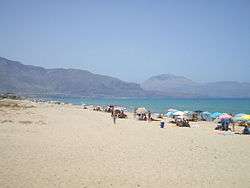
Natural areas
Among the areas of naturalistic interest near Alcamo there are the beaches of Alcamo Marina, the Nature Reserve Bosco di Alcamo on Mount Bonifato and the Segestan thermal baths. The hot springs are produced by the reclimbing of water of meteoric origin which meets the water of Fiume Caldo.[95] They are seven kilometres far from Alcamo and next to the boundary with the territory of Castellammare del Golfo, a small town which shares this naturalistic attraction with Alcamo. According to the narration given by Diodorus Siculus, they were created by the nymphs to favour Eracle's rest during his trip from Piloro to Erice.[47]
Hinterland
The surrounding areas include interesting touristic and historical locations like Segesta and Gibellina. The old fishing village of Scopello, 20 kilometres (12 mi) from Alcamo, has been referred to as having a remarkable seaside. Another small town considered worth visiting is Castellammare del Golfo which is between these two places.
Society
Demographical evolution
| Historical population | ||
|---|---|---|
| Year | Pop. | ±% |
| 1861 | 19,531 | — |
| 1871 | 20,934 | +7.2% |
| 1881 | 37,497 | +79.1% |
| 1901 | 51,798 | +38.1% |
| 1911 | 32,211 | −37.8% |
| 1921 | 63,765 | +98.0% |
| 1931 | 51,687 | −18.9% |
| 1936 | 38,396 | −25.7% |
| 1951 | 41,815 | +8.9% |
| 1961 | 43,097 | +3.1% |
| 1971 | 41,596 | −3.5% |
| 1981 | 42,339 | +1.8% |
| 1991 | 42,621 | +0.7% |
| 2001 | 43,890 | +3.0% |
| 2011 | 45,314 | +3.2% |
| Source: Statistiche I.Stat ISTAT URL consultato in data 28 December 2012. | ||
Ethnic groups and foreign minorities
According to the ISTAT data of 1 January 2013, the foreign people resident in Alcamo were 1,258 people corresponding to the 2.58% of the residing population.[96] The most represented nationalities, according to the percentage on the total residing population, were:[96]
-
 Romania 727 (1.62%)
Romania 727 (1.62%) -
 Morocco 155 (0.34%)
Morocco 155 (0.34%) -
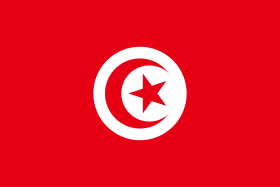 Tunisia 118 (0.26%)
Tunisia 118 (0.26%) -
 Albania 60 (0.13%)
Albania 60 (0.13%) -
 China 31 (0.07%)
China 31 (0.07%) -
 Poland 22 (0.05%)
Poland 22 (0.05%) -
 Serbia 15 (0.03%)
Serbia 15 (0.03%)
Culture

The poet Cielo d'Alcamo (known also as "Ciullo d'Alcamo") was the author of the contrasto "Rosa fresca aulentissima".[23] He wrote in vernacular in the 12th century and was from Alcamo. Many important places of the town, such as the main square, the theatre and the Classical Lyceum founded in 1862, have been named after the famous poet.

From the cultural point of view, in the following centuries Alcamo saw the rise of activities connected with arts such as the construction of churches and buildings, first in the baroque and then Renaissance style, with the coming of several artists of international level: painters (like Guglielmo Borremans and the very talented Pietro Novelli from Monreale), sculptors (Antonello Gagini and Giacomo Serpotta) and other various artists who embellished the town's image. Inside the castle of Alcamo there is a puppet theatre and they often give performances. During the feasts in Alcamo there are often streets entertainers and pedlars selling sweets, dried fruit and different objects in their stands called "baracchelle".
Media
Radio
There is a local radio, Radio Alcamo Centrale, which operates in the territory since 1976.[97]
Press
The oldest periodical in Alcamo is "Il Bonifato".[98]
Television
The networks in Alcamo are Alpa Uno (since 1976) and Video Sicilia (since 1987).
Music
.jpg)
In 1880 they founded the Premiato Complesso Bandistico "Città di Alcamo", which is the oldest band in the province of Trapani.[99] In the first years it was led by the baron Giuseppe Triolo di Sant'Anna.[99] In 1892, during a contest with the other Sicilian musical bands (and under the direction of the famous Maestro Raffaele Caravaglios), it won the honour Diploma and the golden Medal, that is why it is named premiato(=prized).[99]
Since 1986 there is in Alcamo the Associazione Amici della Musica (The Association of Music's Friends), which promotes and organizes concerts of lyrical music, international contests and prizes also in other towns in the province of Trapani and Palermo.[100]
The Associazione Jacopone da Todi, founded in 1989, has the objective of spreading the knowledge of holy art, in its different expressions; the Director is Gaetano Stellino, a school teacher.
The Coro Mater Dei is a musical association born in 1998 and made up of about 30 members; it has held various concerts (especially during the Christmas holidays) in the province of Trapani. The chorus master is Baldo Barone.
The Coro Francesca Adragna was founded in 2008 under the direction of the chorus master Maria Messana. It has a very varied repertory: arias from operettas, opera melodies, church music, Sicilian popular tunes and Neapolitan songs.
_02.jpg)
There is also the Brass Group, the promoter of the "Summertime Blues Festival", which was held for various consecutive years in Piazza Ciullo and where blues singers and musicians from different parts of the world took part.[101]
Religious traditions and folklore
- 19 March: celebration in honour of Saint Joseph (novena and procession)
- Good Friday: procession of the Dead Jesus and Our Lady of Sorrow.
- First Sunday after Easter: Feast of Jesus Christ the Redeemer (cultural and religious event).
- Second Sunday after Easter: celebration in honour of Saint Francis of Paola (cultural and religious event).
- Third Sunday after Easter: Feast of Patrocinio in honour of the Holy Family (procession and lunch with the Holy Family).
- 1 May: celebration in honour of Saint Joseph the Worker (novena and procession)
- 13 June: celebration in honour of Saint Anthony of Padua (novena and procession)
- 19–21 June: Celebration in honour of Maria Santissima dei Miracoli (Saint Mary of Miracles, the patron saint of Alcamo): cultural and religious events. During the feast there are a solemn procession of the Madonna's simulacrum, fireworks from the "bastione" in Piazza Bagolino and the descent of civil and political authorities to the Sanctuary of Madonna of Miracles. In the past (until 8–10 years ago) there were horse races along Corso 6 Aprile; the last two times they took place in Viale Italia.
- End of July: Saint Anne's feast with novena, procession and cultural-recreational activities.
- 8 September (Nativity of Mary): celebrations at the Sanctuary of Most Holy Mary of the Height (Madonna dell'Alto) on the top of Mount Bonifato with dialect poems recitation and procession.
- 7–8 December: celebration in honour of Immacolata Concezione (the Immaculate Conception): novena, pastoral melodies and procession.
- Alcamo Christmas (concerts, outdoor performances, preparation of traditional Christmas cribs and pipers' passing).
Recreational activities
- July–August: Alcamo Estate ("sagras" or festivals, "Calici di Stelle", "Blues Festival", "Festival di Nuove Impressioni")
- Second half of August: "Alcart – legalità e cultura" (Legality and Culture) a series of events (exhibitions,seminars, music,theatre etc.).
- Second or third week-end of December: Cortiamo – International Contest of short films organized since 2006 by "Segni Nuovi" (a club of cinematographic culture within the Church of the Saints Paul and Bartholomew).
Sport events
- 2–6 January: International Costa Gaia Trophy (youth soccer tournament).
Local market
The local market in Alcamo (called "mercatino") takes place every Wednesday morning in Via Tre Santi, near Viale Italia.[102][103]

Cuisine
Some specialities of cuisine of Alcamo are:
- Handmade maccheroni
- Pasta with "finocchi and sarde" (wild small fennels and sardines)
- Sausages with "cavuliceddi" (a typical Alcamo vegetable)
- Dried filled tomatoes[104]
- Cuddureddi (Christmas handmade fig sweets)
- Tetù (mixed and coloured biscuits)
- Sciù (cream sweets)
- Muffulette (fresh cooked roll bread with ricotta or other fillings)
Notable People
.jpg)
- Cielo d'Alcamo (13th century), poet
- Arcangelo Placenza from Calatafimi Piacentini da Calatafimi (1390–1460), presbyter and Francescan friar[105]
- Sebastiano Bagolino (1560–1604) poet and painter [23]
- Guglielmo Borremans (1672–1744) Flemish painter
- Agostino Pantò, founder of Accademia giustinianea (1675–1735)[23]
- Ignazio De Blasi (1717-1783) historian[23]
- Giuseppe Renda (1772-1805), painter [23]
- Felice Pastore Cambon (1786–1862), baron of Rincione, politician and benefactor
- Girolamo Caruso (1842-1923), agronomist and teacher at university
- Benedetto Di San Giuseppe (1847–1906), politician and senator of Reign of Italy in the XVIII Legislature
- Pietro Maria Rocca (1847–1918), historian
- Francesco Maria Mirabella (1850–1931), historian, school teacher, poet
- Don Giuseppe Rizzo (1863–1912), presbyter, founder of the homonym Cassa Rurale ed Artigiana[106]
- Nino Navarra (poeta) 1885–1917 poet, writer, gold medal for his military value
- Vito Fazio Allmayer 1885-1958, philosopher, pedagogist and teacher at university
- Pietro Montana (1890–1978), sculptor, painter and teacher.
- Vincenzo Rimi (1902–1975), criminal
- Nicola Rubino (1905–1984) sculptor and painter
- Giuseppe Cottone, literary critic (1905–2009)
- Don Ignazio Provenza (1911–1943), priest and military chapelain, dead during World War II
- Monsignore Vincenzo Regina (1910–2009), historian, presbyter
- Vito Guarrasi (1914–1999), lawyer and entrepreneur
- Salvatore Asta (1915–2004), Catholic archbishop
- Gino Patti (1925-1993), painter
- Ludovico Corrao (1927–2011), politician and senator.
- Turi Simeti (1929), painter.
- Francesco Parrino, (1931–1985), senator and Undersecretary for the Arts in Fanfani 5th government.
- Carlo Cataldo (1933), historian and poet.
- Nicolò Mineo (1934), literary critic and academician.
- Francesco Paolo Lucchese (1935), doctor and deputy.
- Baldassare Lauria (1935), doctor and senator.
- Vincenza Bono Parrino (1942), Minister for the Arts in De Mita's government.
- Franca Viola (1947), the first Italian woman who refused the repairing wedding.
- Andrea Occhipinti (1957), actor and film producer.
- Giuseppe Lo Presti (1958–1995), writer and criminal
- Massimo Saverio Ennio Fundarò (1958), politician and deputy.
- Antonino Papania (1959), politician and senator.
- Antonino Raspanti (1959), Catholic bishop.
- Christian Rocca (1968), journalist and writer
- Ignazio Corrao (1984), politician and eurodeputy
- Giuseppe Pipitone (1987), journalist and writer.
- Sara Renda (1991), Étoile at the Opéra National de Bordeaux.
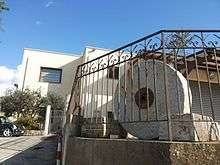
.jpg)
Economy
Alcamo is one of the most important centres in Sicily for wine production, especially Bianco Alcamo D.O.C.,[107] made from vineyards with espailer or "tendone" structures and using white common or bright catarratto vines, eventually associated with damaschino, grecanico and trebbiano.[47]
Besides the wine activity there are cattle and sheep breeding, olive growing (for the extraction of extra virgin olive oil),[47] cereals (particularly wheat) and the typical oval melon, with a green wrinkled peel, locally called "miluni purceddu",[47] which has the peculiarity that can be kept longer than other kinds of melon.[47]
In the primary sector it is also significant quarrying (of different marbles and mostly travertino), though the tertiary sector (more or less advanced) has however got the majority of employed people.
Transports and infrastructures
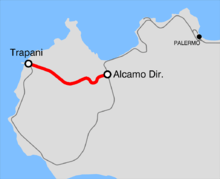
There are two motorway junctions from Autostrada A29 Palermo-Mazara del Vallo: Alcamo Est and Alcamo Ovest, apart the junction of Castellammare del Golfo which links up with the north entrance to Alcamo. Another motorway junction is from Alcamo Ovest (Autostrada A29 diramazione Alcamo-Trapani). Alcamo is crossed by two National Roads: strada statale 113, connecting Trapani with Messina, and strada statale 119, connecting Alcamo with Castelvetrano. The Railway line doesn't pass through the town centre but along the coast, then inland on the west side. The railway station of Alcamo Diramazione is located near the motorway junction of Alcamo Ovest and the station of Castellammare del Golfo is situated in the territory of Alcamo, precisely at Alcamo Marina.
These State Highways (or National Roads) pass through Alcamo:
- SS 113 Settentrionale Sicula;
- SS 119 of Gibellina;
- SS 187 of Castellammare del Golfo;
- SS 731 Link Road (Bretella) of Castellammare del Golfo;
- SS 732 Link Road (Bretella) of Alcamo Est;
- SS 733 Link Road (Bretella) of Alcamo Ovest.
These Regional Roads (SR) of Sicily:
- SR 2 Parti Piccolo-Quaranta Salme-Croce di Fratacchia;
- SR 3 Alcamo-Giardinaccio-Rocche Cadute-San Nicola;
- SR 5 Bivio Quaranta Salme-Bivio Sant'Anna;
- SR 6 of Calatubo;
- SR 8 Amburgio-Morfino-Rincione-Coda di Volpe.
And also these Provincial Roads (SP) of the province of Trapani pass through Alcamo:
- SP 10 for Camporeale;
- SP 33 of Fiumefreddo
- SP 47 for Alcamo-Station of Castellammare del Golfo;
- SP 49 for Passofondo;
- SP 55 Alcamo-Alcamo Marina.
- SP 64 Quattrovie.
In the area of Alcamo there are also the following draining roads of the province of Trapani:
- SB 21 Bisurdo-Stracciabisacce;
- SB 22 Case di Piraino;
- SB 23 Maruggi-Montelongo.
Along the National Road Palermo-Sciacca (SS 624) there is the exit "Alcamo" in both directions and is about 30 km from on the south-west side of the town. This exit, wholly located in the territory of Poggioreale, connects with the National Road of Gibellina (SS 119) near the ex railway station and motorway junction of Gallitello through the Provincial road SP9 (of the series n.182 Macchia-Sella-Bonfalco) and the SB0 (a local link road of Gibellina), to the border between the territories of Poggioreale and Monreale.
Alcamo is about 40 km from the airport "Falcone-Borsellino Airport" of Palermo-Punta Raisi and about 50 km from the "Vincenzo Florio Airport" of Trapani-Birgi.
Administration
Twin towns
Sport

The most popular and practised sport in Alcamo, as in most Italian towns, has always been soccer; the greatest team is the Alcamo team, which was in the past a protagonist in some football seasons in League C (Italian Serie C), for its victories against Bari and Crotone, and in League D. Apart various regional trophies, it has won the Coppa Italia Dilettanti in 1996 and the subsequent Supercoppa Italiana Dilettanti. Together with the golden period in League C, these were the most beautiful pages of the football history in Alcamo. A recent society crisis has caused bankruptcy and the team which played in League D had to restart from the First Category League. Today it competes in the regional Eccellenza championship following the 2010 refoundation. The activity of juvenile soccer is very active, and the Adelkam football school emerges among the various youth teams because it has launched different football players and has won a lot of national and international competitions. Alcamo is also the principal centre of the Costa Gaia International Trophy, a youth football kermess in which a lot of titled teams take part and where many great players of the bigger championships have been the protagonists.

Basket is also very popular and practised, today with better results than football anyway. The female team Basket Alcamo (Gea Magazzini) which has obtained important results in its history (a long participation in A1 League and the final match in the Ronchetti Cup), has played in the A2 League for eleven years, and has regained the major league in the season 2011–2012. The male team has also obtained good results, but not at the same levels.
The local handball team, Pallamano Alcamo plays its home matches at the Palasport Enzo D'Angelo.
Sport facilities
The town has got several sport facilities, the most important are the stadium Lelio Catella (with a capacity of about 10,000 people) for football and athletics, the Palazzetto dello Sport(sports hall) Tre Santi for Basket and the Palasport Enzo D'Angelo (indoor stadium) for handball. There is a private swimpool open to public use (La Fenice) where young boys (who have won National prizes) train regularly. In the same facility there is an ice-skating rink. When Alcamo football team played in League C, the home matches were played at stadium Don Rizzo, which together with Sant'Ippolito stadium, is now used by juvenile and minor teams
Sports personalities
- Gino Colaussi (1914–1991), national football player and trainer for Alcamo team
- Charley Fusari (1924–1985), US boxer
- Gaspare Umile (1948–2001), ex football player
- Cynthia Cooper (1963), ex player for Basket Alcamo
- Jean Alesi (1964), ex French car-racer
- Antonino Asta (1970), ex football player and trainer.
- Lisa Leslie (1972), ex player for Basket Alcamo
- Loretta Vaccaro (1973), ex cestista
- Adalgisa Impastato (1974), ex basket player.
- Rosalia Messina (1976), ex basket player
- Dalila Cucchiara (1979), ex basket player
- Giuseppe Scurto (1984), ex football player and trainer.
- Giacomo Di Donato (1988), ex football player
See also
| Wikimedia Commons has media related to Alcamo. |
Notes
- 1 2 Comuni-Italiani.it
- ↑ tuttitalia.it – Alcamo
- 1 2 3 4 5 6 7 8 climate-data.org
- ↑ "Climate: Alcamo". Climate-Data.org. Retrieved 19 May 2016.
- ↑ Comuni-Italiani.it, "Alcamo: Clima e Dati Geografici"
- 1 2 Regina 1972, p. 16.
- ↑ Regina 1972, p. 20.
- 1 2 3 AlqamaH – Historia Alcami: Reperti archeologici. Piccole tracce della storia di Alcamo
- 1 2 Gruppo Archeologico Drepanon 2014, pp. 17–18.
- 1 2 3 4 5 Alcamo e le origini da Longuro, Longarico
- ↑ Orlandi 1770, p. 204.
- ↑ Nuove effemeridi siciliane
- 1 2 3 4 Regina 1972, p. 15.
- 1 2 3 4 5 6 7 8 9 10 "Alcamo", Enciclopedia Italiana (1929)
- ↑ AAVV 1991, p. 4.
- ↑ Orlandi 1770, pp. 204–205.
- 1 2 San Martino De Spucches & Gregorio 2013, p. 50.
- 1 2 3 AAVV 1991, p. 6.
- 1 2 3 4 AAVV 1991, p. 8.
- 1 2 AAVV 1991, p. 14.
- 1 2 AAVV 1991, p. 10.
- 1 2 AAVV 1991, p. 12.
- 1 2 3 4 5 6 7 8 9 Comune di Alcamo – Storia e tradizioni
- 1 2 3 Historia Alcami: I Palazzi storici – Intervista al Prof. Roberto Calìa, storico.
- ↑ AAVV 1991, p. 15.
- 1 2 3 4 5 AAVV 1991, p. 16.
- 1 2 3 AAVV 1991, p. 18.
- 1 2 3 4 5 6 7 8 9 AAVV 1991, p. 20
- ↑ Chiarelli 2005, p. 96.
- 1 2 3 4 5 6 Chiarelli, Andrea; Cocchiara, Dario (2005). Alcamo nel XX secolo , Volume I: 1900–1943 (in Italian). Campo Edizioni.
- ↑ Chiarelli 2005, p. 42
- ↑ Chiarelli 2005, p. 61.
- ↑ Chiarelli 2005, p. 43.
- 1 2 3 4 5 http://www.tp24.it/2015/08/17/inchieste/la-storia-della-prima-officina-elettrica-di-alcamo/93500
- ↑ Chiarelli 2005, p. 147.
- ↑ Società italiana per condotte d'acqua – Il dopoguerra e le opere del regime
- 1 2 Chiarelli 2005, p. 120.
- ↑ Chiarelli 2005, p. 143.
- ↑ la Repubblica.it, "Un colpo all'eroina SpA"
- ↑
Chiarelli (Vol. I)
— p. 297. - 1 2 3 4
Chiarelli (Vol. I)
— p. 299-300. - ↑ AlpaUno, "Alcamo: Castello Calatubo, volontari ripuliscono la cappella"
- ↑ AlqamaH, "Muore Gae Aulenti, aveva riqualificato Piazza Ciullo"
- ↑ Raccolta differenziata al 50 per cento, Alcamo nel club dei Comuni virtuosi
- ↑ Orlandi 1770, p. 207.
- ↑ Trapani Nostra – Accanto alle Aquile di Carlo Cataldo
- 1 2 3 4 5 6 7 8 9 10 11 12 13 14 15 16 Comune di Alcamo, "Alcamo"
- ↑ Regina & p. 52
- ↑ Regina & p. 51
- ↑ (Italian) TP24.it – Luigi Culmone, "La storia della prima Chiesa Madre di Alcamo"
- ↑ (Italian) I monumenti di Alcamo
- ↑ (Italian) Sicilie.it, "Alcamo – Chiesa Santissimi Paolo e Bartolomeo"
- ↑ trapaniplus – Ex chiesa San Giacomo de Espada
- ↑ Cataldo, Carlo (1982). Guida storico-artistica dei beni culturali di Alcamo, Calatafimi, Castellammare del golfo, Salemi, Vita. Alcamo: Sarograf.
- ↑ Comune di Alcamo – Chiesa di San Tommaso
- ↑ trapaniplus – Chiesa di San Tommaso
- ↑ trapaniplus – Chiesa di Santa Maria del Gesù Alcamo
- ↑ trapaniplus – Ex chiesa S. Maria del Soccorso
- ↑ trapaniplus – Chiesa del monastero del SS Salvatore
- ↑ Chiesa di Sant'Oliva
- ↑ trapaniplus – Chiesa di Sant'Oliva
- ↑ Comune di Alcamo – Santuario di Maria Santissima dei Miracoli
- ↑ trapaniplus – Santuario Maria SS. dei Miracoli
- ↑ Comune di Alcamo – Chiese e monumenti
- ↑ Comune di Alcamo – Chiesa dell'Annunziata
- ↑ trapaniplus – Chiesa di Maria SS. Annunziata
- ↑ trapaniplus – Ex chiesa di San Nicolò di Bari
- ↑ Comune di Alcamo – Basilica di Santa Maria Assunta
- ↑ trapaniplus – Sacra spina
- ↑ Provincia di Sicilia dei Frati Minori Conventuali – Convento San Francesco d'Assisi
- ↑ Comune di Alcamo – Chiesa dei Santi Paolo e Bartolomeo
- ↑ Chiesa dei SS Paolo e Bartolomeo
- ↑ trapaniplus – Chiesa di Santa Maria delle Grazie
- ↑ trapaniplus – Chiesa di Sant'Anna
- ↑ trapaniplus – Chiesa delle Riparate
- ↑ Comune di Alcamo – Chiesa del Gesù
- ↑ trapaniplus – Chiesa del Gesù
- ↑ Comune di Alcamo – Chiesa dei Santi Cosma e Damiano
- ↑ trapaniplus – Chiesa dei SS Cosma e Damiano
- ↑ La scultura di Serpotta
- ↑ Comune di Alcamo – Monastero di S. Francesco di Paola (Badia Nuova)
- ↑ trapaniplus – Chiesa della Badia Nuova
- ↑ trapaniplus – Chiesa della SS. Trinità
- ↑ trapaniplus – Ex chiesa Ecce Homo
- ↑ trapaniplus, Ex chiesa di S. Maria del Rosario
- ↑ trapaniplus – Chiesa di Maria SS. Dell'Alto
- ↑ Chiesa Parrocchiale delle Anime Sante trapaniplus – Chiesa Parrocchiale delle Anime Sante
- ↑ Parrocchia Sacro Cuore di Gesù, Alcamo
- ↑ La Chiesa del Redentore – Alcamo
- ↑ Mariangela Ettari, "Il Castello di monte Bonifato"
- ↑ Malanima & p. 75.
- 1 2 iCastelli.it, "Castello Di Calatubo"
- 1 2 3 4 ideazionenews.it – "Alcamo: il più antico edificio, ancora integro, è del 980. Istituzioni e storici però non ne parlano"
- ↑ Comune di Alcamo – Alcamo Marina
- ↑ Terme Libere di Segesta
- 1 2 tuttitalia.it – Cittadini stranieri Alcamo 2013
- ↑ Radio Alcamo Centrale – Storia
- ↑ http://www.teleoccidente.it/2009/07/una-universita-ad-alcamo/3570 Teleoccidente, "Una università ad Alcamo"
- 1 2 3 BandaMusicale.it – Premiato Complesso Bandistico "Città di Alcamo"
- ↑ Associazione Amici della Musica – Chi Siamo
- ↑ Io amo la Sicilia – Summer Blues Festival 2013 Winter Edition
- ↑ VirgilioCittà – Alcamo, Mercato Rionale
- ↑ Comune di Alcamo – Calendario anno 2013 delle giornate lavorative presso il mercatino settimanale del mercoledì
- ↑ Pomodori secchi ripieni all'alcamese, il gusto della tradizione
- ↑ Beato Arcangelo Piacentini da Calatafimi
- ↑ Banca Don Rizzo – Credito Cooperativo della Sicilia Occidentale
- ↑ Comune di Alcamo – L'economia locale
Sources
- Regina, Vincenzo (1972). Profilo storico di Alcamo e sue opere d'arte dalle origini al secolo XV (in Italian). Edizioni Accademia di Studi "Cielo d'Alcamo".
- Mirabella, Francesco M. (1876). Cenni degli alcamesi rinomati in scienze, lettere, arti, armi e santità. Alcamo: Surdi.
- Le guide oro – Sicilia. Firenze: Casa editrice Bonechi. 1992.
- Calia, Roberto; Craparo, Enzo; Baldassano Cataldo, Erina (1991). La Bella Alcamo. Alcamo: Edizioni Blu Imaging & Adv.
- Chiarelli, Andrea; Cocchiara, Dario (2005). Alcamo nel XX secolo , Volume I: 1900–1943 (in Italian). Campo Edizioni.
- Chiarelli, Andrea; Cocchiara, Dario (2009). Alcamo nel XX secolo , Volume II: 1944–1999 (in Italian). Campo Edizioni.
- Orlandi, Cesare (1770). Delle location d'Italia e sue isole adjacenti compendiose notizie (in Italian).
- San Martino De Spucches, Francesco; Gregorio, Mario (2013). La storia dei feudi e di titoli nobiliari della Sicilia dalla loro origini ai nostri giorni (in Italian). Lulu.com. ISBN 1-300-84355-1.
- Gruppo Archeologico Drepanon (2014). Bonifato – La montagna ritrovata (in Italian). Trapani: Il Sole editrice. ISBN 978-88-905457-3-3.
- Bembina, G. B.; Mirabella, Francesco Maria; Pietro Maria, Rocca (1956). Alcamo sacra (in Italian). Alcamo: Tipografia Cartografica.
- Malanima, Paolo (2009). Pre-Modern European Economy: One Thousand Years (10th–19th Centuries). BRILL. ISBN 90-04-17822-8.
- Marsala, M. T. (1980). Atlante di Storia Urbanistica Siciliana "Alcamo". Palermo: Flaccovio S.F.
- Mirabella, Gaspare (1981). Alcamo quello che resta... Alcamo: Sarograf.
- Mirabella, Francesco Maria (1980). Alcamensia noterelle storiche con appendici di documenti inediti. Alcamo: Sarograf.
- Calia, Roberto (1991). Una città da scoprire: Alcamo. Alcamo: Edizioni Blu Imaging & ADV.
- Calia, Roberto (1992). Lo Stemma della Città di Alcamo (attraverso i secoli). Alcamo: Sarograf.
- Regina, Vincenzo (1975). Storia società e cultura dal cinque al settecento. Alcamo: Edizioni Accademia di studi "Cielo D'Alcamo".
- Calia, Roberto (1997). I palazzi dell'aristocrazia e della borghesia alcamese. Alcamo: Carrubba.
- Regina, Vincenzo (1977). Ottocento alcamese storia e arte. Alcamo: Edizioni Accademia di studi "Cielo D'Alcamo".
- Regina, Vincenzo (1956). Brevi note su Alcamo del 1700. Alcamo: Edizioni Accademia di studi "Cielo D'Alcamo".
- Regina, Vincenzo (1992). Alcamo una città della Sicilia. Palermo: Aracne.
- Mirabella, Francesco Maria (1919). Sull'origine della città di Alcamo. Acireale: Popolare.
- Di Giovanni, V. (1876). Notizie storiche della città di Alcamo. Palermo: Amenta M.
- Rocca, Pietro Maria (1894). Delle muraglie e porte della città di Alcamo. Palermo: Lo Statuto.
- Regina, Vincenzo (1982). Bonifato Terra Sicana Elima da Lungaro a Longarico. Alcamo: Cartograf.
- Di Graziano, A. A. (1981). Note e documenti per la storia di Alcamo nei secoli XIII e XIV. Roma: Centro Ricerca.
- Regina, Vincenzo (1986). Alcamo, paesaggio urbano e rurale. Alcamo: Edizioni Leopardi.
- Bembina, G. B. (1979). Storia ragionata della città di Alcamo. Alcamo: Editrice Zulemia.
- De Blasi, Ignazio (1880). Della opulenta città di Alcamo. Discorso storico. Alcamo.
- Trasselli, C. (1971). Alcamo un comune feudale del trecento. Trapani: Corrao G.
- Regina, Vincenzo (1979). Alcamo dalla prima guerra mondiale ai giorni nostri. Alcamo: Edizioni di Studi "Cielo D'Alcamo".
- Mirabella, Francesco Maria; Rocca, Pietro Maria (1884). Guida artistica della città di Alcamo. Alcamo: Bagolino.
- Polizzi, G. (1879). I monumenti di antichità e d'arte della provincia di Trapani. Trapani.
- Maniaci, G.; Di Bernardo, R. (1974). Espansione e problema ecologico nel comprensorio di Alcamo. Alcamo: Damiano Campo.
- Città di Alcamo – Assessorato al Turismo (2002). Alcamo – un itinerario guidato per una città tutta da scoprire...
- Cataldo, Carlo (2001). La conchiglia di S. Giacomo. Alcamo: Edizioni Campo.
- Cataldo, Carlo (1982). Guida storico-artistica dei beni culturali di Alcamo, Calatafimi, Castellammare del golfo, Salemi, Vita. Alcamo: Sarograf.
- Regina, Vincenzo (2002). Cavalieri ospedalieri e pellegrini per le antiche vie della provincia di Trapani.
- Longo, Ignazio (2013). Terra Alcami. Imago Urbis. Rappresentazioni iconografiche e cartografiche antiche. Rome: Aracne editrice. ISBN 978-88-548-6350-7.
External links
| Wikivoyage has a travel guide for Alcamo. |
- Official website (Italian)
- Alcamo.it
- Notizie storiche, foto di Alcamo, informazioni, curiosità, etc.
- Financial Club – Associazione Culturale per la promozione della cultura d'impresa
- Alcamo Information
- Al centro delle colline Alcamo D.O.C.
